
|
|||||||||||||||||||||
|
In a period of painfully close presidential elections, with the most dangerous White House in history hoping to extend its criminal reign, every American vote in 2004 is potentially a matter of life and death for masses of people at home and abroad. It is exceedingly significant, therefore, that 4.4 million Americans are disenfranchised due to a past or current felony conviction. No other nation imprisons a larger share of its population or marks so large a share of its population with the lifelong mark of a serious (felony) criminal record. According to the best estimates last year, 13 million Americans – fully 7 percent of the adult population and an astonishing 12 percent of the adult male population – possess felony records. At the same time, no other democratic nation denies the vote to a remotely comparable share of its offender and ex-offender population. According to Jeff Manza and Christopher Uggen, the leading academic authorities on felon and ex-felon voting rights, "48 states disenfranchise incarcerated felons, 37 states disenfranchise felony probationers or parolees (or both), and 14 states additionally disenfranchise some or all ex-felons who have completed their sentences." America’s army of disenfranchised felons and ex-felons "are expected," note Manza and Uggen, "to respect the law (and indeed, are often subject to significantly harsher penalties and face a higher level of scrutiny, than non-felons). They are expected to pay taxes to the government, and to be governed by elected officials. Yet they have no formal right to participate in the selection of those officials or the public policies that allocate government expenditures." Among those expenditures we might include the hundreds of billions of dollars that American governments spend on mass surveillance, arrest, detention, prosecution, incarceration, and post-release criminal supervision.
Florida, History and the Color of Felony Disenfranchisement Anyone
who doubts the historical significance of this mass denial
of basic voting rights
need only review the considerable literature, academic and otherwise,
that is now readily available on the dark and fateful presidential
selection of 2000. As scholars (Uggen and Manza) and journalists
(see the first chapter, titled “Jim
Crown in Cyperspace” in Greg Palast’s bestselling The
Best Democracy Money Can Buy) have shown beyond the shadow
of reasonable doubt, Florida’s disenfranchisement of felons and
ex-felons was sufficient in and of itself to saddle America and
the world with the terrible Bush regime. But for that policy,
Uggen and Manza demonstrate, Al Gore would have picked up 60,000
additional votes in Florida, home to 1,088,667 ex-felons and
Manza and Uggen’s dark finding rests largely on the very disproportionately black composition of America’s official criminal class within and beyond Florida, a reflection of criminal justice disparities so great that an astonishing one in three black adult males in the United States carries a felony record. Manza and Uggen factor in and cross-match all the relevant social-science inputs on race, socioeconomic status, party identification, and voter turnout to show that felony disenfranchisement was a wining tool for the Republican Party, consistent with broader and related Republican efforts to minimize and dilute the heavily Democratic weight and significance of the black vote. Anyone concerned about the prospect of long-term Republican hegemony in the American Party system should support the movement to extend the ballot to ex-felons – a reform that is supported by 80 percent of Americans according to a recent poll. The Policy-Driven Color of Felony Marking Of course, partisan consequences should hardly be the only concern. Elementary considerations of fairness and forgiveness should leave no room for the vicious practice of imposing medieval “civil death” upon people who have broken society’s laws. At the same time, those who think that losing one’s vote is an appropriate punishment for violation of the “social contract” through criminal behavior should consider the fact that the astonishing boom of America’s prison, felon, and ex-felon numbers during the last 30 years is – like felony disenfranchisement – a state policy. Contrary to the "law and order" rhetoric cultivated by many politicians and policymakers, there has been no clear or consistent pattern of rising criminality, including violent criminality that can remotely explain the simply remarkable off-the-charts expansion of America's racially disparate prison, criminal supervision felon and ex-felon population during the last three decades. The central factor is that imprisonment and related felony-marking in the US have "changed," in Northwestern University sociologist Devah Pager's words, "from a punishment reserved for only the most heinous offenders to one extended to a much greater range of crimes and much larger segment of the population." People who committed nonviolent, especially drug crimes accounted for more than three fourths of the nation's increase in prisoners between 1978 and 1996. These trends have impacted black communities with special harshness. While blacks make up just 15 percent of illicit drug users, they account for 37 percent of those arrested for drug offenses. They comprise 42 percent of those held in federal prison for drug charges and 62 percent of those in state prisons. Blacks constituted more than 75 percent of the total drug prisoners in America in one third of all states according to a report issued in 2000 by the prestigious human rights organization Human Rights Watch. Black crime rates have been consistently higher than the white crime rate, consistent with blacks' lower socioeconomic status and related higher stress levels and weaker social and familial structures, but there has been no massive upsurge of black criminality that could even remotely explain the skyrocketing black incarceration and felony rates. The Three-Fifths Compromise Lives There’s more to the story of how the criminal justice system is working to reduce African-American’s political power in the United States. One key related issue relates to legislative redistricting in our geography-based representative system of single-member districts and winner-take-all elections. In a disturbing re-enactment of the notorious three-fifths clause of the US Constitution, whereby 60 percent of the ante-bellum South's non-voting and un-free (slave) black population counted towards the congressional representation of Slave states, 21st century America’s very disproportionately black and urban prisoners count towards the political apportionment (representation) accorded to predominantly white and rural communities that tend to host prisons in, say, “downstate” Illinois or “upstate” New York. Thus, if a Chicagoan like me takes a one-year position at Southern Illinois University in Carbondale but maintains a residence on the predominantly black and Democratic South Side of Chicago, I still contribute to the likelihood that Chicago and the South Side will have a large number of state representatives and Congresspersons. But if I get arrested and then sentenced to 2 years in the Big Muddy correctional facility in very predominantly white far-southern, Illinois, I'll count towards the political representation of whiter and more Republican Southern Illinois.
To get a sense of how this plays out in terms of racial political power, consider some numbers from my own home state. The Chicago metropolitan area is home to 83 percent of the state's African-Americans and point of origin for 70 percent of the state's prisoners. Nearly two thirds (64 percent) of the state's 45, 629 prisoners in 2001 were African-American, a percentage more than four timers greater than blacks' share of Illinois' population. Forty-four percent of the state's prisoners are African Americans from Chicago’s Cook County. Eighteen of the twenty adult correctional facilities constructed over the last two decades in Illinois are located in counties that are disproportionately white for the state. Just four of the state's twenty post-1980 prison towns have above-average black populations for the state but in three of those this is only because they get to report prisoners as part of their population. Five of the six adult Illinois correctional centers constructed in the 1990s are located in the southern third of the state. Visitors to such very visibly white downstate towns as Ina, Illinois (home of the Big Muddy Correctional Center), would be surprised to learn from the Census Bureau that that community is 42 percent African-American and 90 percent male. The explanation, of course, is mass incarceration. It’s not enough, apparently that each black prisoner is worth tens of thousands of economic development dollars. According to distinguished criminologist Todd Clear, writing in 1996, the prison boom fed by the rising “market” of Black offenders is in fact a remarkable economic multiplier for communities that are often far removed from urban minority concentrations. “Each prisoner,” he found “represents as much as $25,000 in income [annually] for the community in which the prison is located, not to mention the value of constructing the prison facility in the first place. This,” Clear says, amounts to “a massive transfer of value [emphasis added].” Part of this “massive transfer,” it should be added, includes state and federal funding allotments granted on the basis of census counts, weighted to increase with the size of a jurisdiction’s poverty population (and most prisoners are poor). An investigation by The Chicago Reporter, an excellent local public affairs magazine, finds that racially disparate mass incarceration’s interaction with the geography of prison construction, political districting rules and federal budgetary practices to cost Chicago’s Cook County nearly $88 million in federal benefits between 2000 and 2010 (see Molly Dugan, “Census Dollars Bring bounty to Prison Towns”). None of that money redounds to the benefit of those who are responsible for it, of course – the prisoners who do not get to drive on the improved roads or enjoy the improved services built and provided with federal and state grants that rise with mass imprisonment’s inflationary impact on local and regional census counts. All of which provides some interesting context for a Chicago Tribune story that bears the perverse title “Towns Put Dreams in Prisons.” (Chicago Tribune, March 20, 2001, 2C:1). In “downstate” Hoopeston, Illinois, the Tribune reported, there was “talk of the mothballed canneries that once made this a boom town and whether any of that bustling spirit might return if the Illinois Department of Corrections comes to town.”
The
same sort of developmental perversity is certainly underway in
other states, including New York, where 66% of a disproportionately
black state inmate population comes from New York City but 91
percent of prisoners are housed in “upstate” prisons. Every single
New York state prison built since 1982 has been constructed in
an “upstate” community and 34 New York State Assembly districts
are based in part on prisoners (see Peter Wagner’s useful The
Prison Index, Prison Policy Initiative, 2003, pp. 38-39). According
to a recent Prison Policy Initiative study titled “Importing
Constituents: Prison and Political Clout in New York,” prisoners
make up 7 percent of a recently formed New York Assembly district
belonging to New York Redistricting Taskforce member Chris Ortloff. Of
the nearly 6,000 black adults in Ortloff’s district, 82.6 percent
are barred by law from ever voting for or against him because
they are prisoners.
Money, Politics and the Prison Industrial Complex
Of course, many Americans don’t vote even though they possess the right to do so. Probably the single biggest factor that keeps Americans out of the ballot box is their all-too accurate perception that the American policy and related candidate-selection processes are all about Big Money lobbying and campaign contributions, so that wealth trumps one-person one-vote in America, "the best money democracy can buy." In this regard it is politically as well as socio-economically relevant that racially disparate mass incarceration and felony marking devastates the earning capacity and wealth potential of black communities. That negative economic impact – great enough for mass incarceration to be discussed as a form of Reverse Racial Reparations – reduces the black community's already poor ability to compete with whites in the money-politics game of special interest influence, campaign finance, lobbying, and public relations, etc. At the same time, of course, the other side of the coin, taxpayer-funded mass incarceration is political super-enfranchisement for others. It generates an enormous amount of wealth for predominantly white prison communities and predominantly white-owned corporations that build and serve prisons. Those special interests, including the prison-guard unions, invest heavily in politics as a down payment to encourage the expansion and preservation of policies that generate a steady army of black and brown “offenders,” the basic core human raw material for the lucrative and powerful prison industrial complex. Every Vote Matters None of this is meant to downplay the significance of the “narrow” issue of reforming election laws and procedures to enfranchise ex-offenders. This is a huge, significant issue in and of itself. It is especially crucial today, of course, in a time of close presidential elections, with humanity endangered by a dark White House cabal that has attained a position of previously unimaginable power on the backs of disenfranchised felons and the victims of September 11, 2001. George W. Bush, Karl Rove, Donald Rumsfeld, John Ashcroft, Paul Wolfowitz and their ilk have seen to it that every single vote counts, as it should in every election in the "land of liberty." Paul
Street ([email protected]) is an urban social policy
researcher in Chicago, Illinois. He
writes on class, race, imperialism and thought control. He
is the author of The Vicious Circle: Race, Prisons, and Community
in Chicago, Illinois, and the Nation (available online at www.cul-chicago.org) |
December 11,
2003 |
||||||||||||
|
||||||||||||
|
|
||||||||||||
| Printer Friendly Version | ||||||||||||
| |
||||||||||||
| |
||||||||||||






















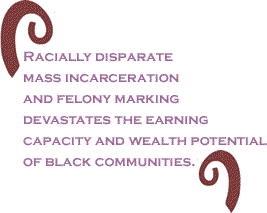
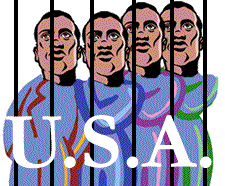
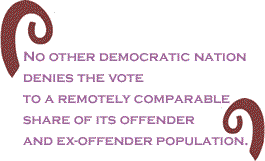
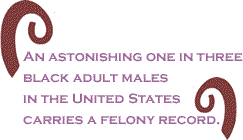 293,396 current felons in the fall of 2000. This was more than
enough to have pre-empted the subsequent melodramas over “hanging
chads,” Jewish votes for Buchanan, butterfly ballots, and the
role of Ralph Nader’s third-party candidacy. Also worth noting,
as Greg Palast has shown, the state of Jeb Bush and Kathleen
Harris also disenfranchised many thousands of other Floridians
falsely suspected of possessing criminal records by a Republican-connected,
vote-scrubbing firm (Database Technologies, a division of ChoicePoint)
that failed to perform minimally adequate fact-checking procedures.
293,396 current felons in the fall of 2000. This was more than
enough to have pre-empted the subsequent melodramas over “hanging
chads,” Jewish votes for Buchanan, butterfly ballots, and the
role of Ralph Nader’s third-party candidacy. Also worth noting,
as Greg Palast has shown, the state of Jeb Bush and Kathleen
Harris also disenfranchised many thousands of other Floridians
falsely suspected of possessing criminal records by a Republican-connected,
vote-scrubbing firm (Database Technologies, a division of ChoicePoint)
that failed to perform minimally adequate fact-checking procedures. 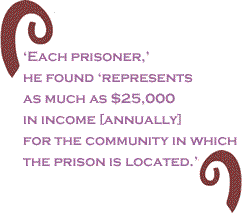
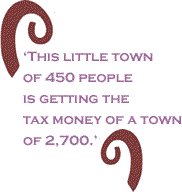 “You don’t like to think
about incarceration,” Hoopeston’s Mayor told the Tribune, “but
this is an opportunity for Hoopeston. We’ve been plagued by
plant closings.” The Hoopeston Mayor’s willingness to enter the
prison sweepstakes was validated by another small town mayor,
Andy Hutchens of Ina, Illinois. According to the Tribune,
in a passage that reminds us to include diversion of tax revenue
among the ways that mass incarceration steals wealth from the
inner city:
“You don’t like to think
about incarceration,” Hoopeston’s Mayor told the Tribune, “but
this is an opportunity for Hoopeston. We’ve been plagued by
plant closings.” The Hoopeston Mayor’s willingness to enter the
prison sweepstakes was validated by another small town mayor,
Andy Hutchens of Ina, Illinois. According to the Tribune,
in a passage that reminds us to include diversion of tax revenue
among the ways that mass incarceration steals wealth from the
inner city: 


